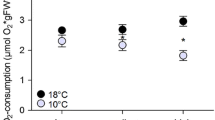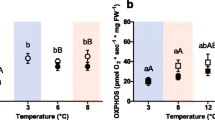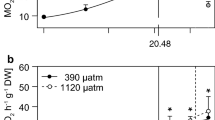Abstract
Oceans are experiencing increasing acidification in parallel to a distinct warming trend in consequence of ongoing climate change. Rising seawater temperatures are mediating a northward shift in distribution of Atlantic cod (Gadus morhua), into the habitat of polar cod (Boreogadus saida), that is associated with retreating cold water masses. This study investigates the competitive strength of the co-occurring gadoids under ocean acidification and warming (OAW) scenarios. Therefore, we incubated specimens of both species in individual tanks for 4 months, under different control and projected temperatures (polar cod: 0, 3, 6, 8 °C, Atlantic cod: 3, 8, 12, 16 °C) and PCO2 conditions (390 and 1170 µatm) and monitored growth, feed consumption and standard metabolic rate. Our results revealed distinct temperature effects on both species. While hypercapnia by itself had no effect, combined drivers caused nonsignificant trends. The feed conversion efficiency of normocapnic polar cod was highest at 0 °C, while optimum growth performance was attained at 6 °C; the long-term upper thermal tolerance limit was reached at 8 °C. OAW caused only slight impairments in growth performance. Under normocapnic conditions, Atlantic cod consumed progressively increasing amounts of feed than individuals under hypercapnia despite maintaining similar growth rates during warming. The low feed conversion efficiency at 3 °C may relate to the lower thermal limit of Atlantic cod. In conclusion, Atlantic cod displayed increased performance in the warming Arctic such that the competitive strength of polar cod is expected to decrease under future OAW conditions.









Similar content being viewed by others
References
Árnason T, Björnsson B, Steinarsson A, Oddgeirsson M (2009) Effects of temperature and body weight on growth rate and feed conversion ratio in turbot (Scophthalmus maximus). Aquaculture 295:218–225
Björnsson B, Steinarsson A (2002) The food-unlimited growth rate of Atlantic cod (Gadus morhua). Can J Fish Aquat Sci 59:494–502
Björnsson B, Steinarsson A, Oddgeirsson M (2001) Optimal temperature for growth and feed conversion of immature cod (Gadus morhua L.). ICES J Mar Sci 58:29–38
Björnsson B, Steinarsson A, Árnason T (2007) Growth model for Atlantic cod (Gadus morhua): effects of temperature and body weight on growth rate. Aquaculture 271:216–226
Bradstreet MSW, Finley KJ, Sekerak AD, Griffiths WB, Evans CR, Fabijan MF, Stallard HE (1986) Aspects of the biology of Arctic cod Boreogadus saida and its importance in Arctic marine food chains. Can Tech Rep Fish Aquat Sci 1491:1–193
Brander KM (1994) Patterns of distribution, spawning, and growth in North Atlantic cod: the utility of inter-regional comparisons. ICES Mar Sci 198:406–413
Brander KM (1995) The effect of temperature on growth of Atlantic cod (Gadus morhua L.). ICES J Mar Sci 52:1–10
Brander KM (2007) The role of growth changes in the decline and recovery of North Atlantic cod stocks since 1970. ICES J Mar Sci 64:211–217
Brander KM (2010) Cod (Gadus morhua) and climate change: processes, productivity and prediction. J Fish Biol 77:1899–1911
Brander KM, Blom G, Borges MF, Erzini K, Henderson G, MacKenzie BR, Mendes H, Santos AMP, Toresen P (2003) Changes in fish distribution in the eastern North Atlantic: are we seeing a coherent response to changing temperature? ICES Mar Sci 219:261–270
Brett JR (1979) Environmental factors and growth. In: Hoar WS, Randall DJ, Brett JR (eds) Fish physiology, vol 8., Academic PressNew York, NY, pp 599–675
Brown JA, Pepin P, Methven DA, Somerton DC (1989) The feeding, growth and behaviour of juvenile cod, Gadus morhua L., in cold environments. J Fish Biol 35:373–380
Christiansen JS (1995) Food consumption and growth rate variations in male and female polar cod (Boreogadus saida). ICES Council Meeting (Theme Session P) Causes of Observed Variations in Fish Growth P:9
Christiansen JS, Schurmann H, Siikavuopio S (1996) Nonthermal correlates of selected temperature in capelin and polar cod–current lines of research. ICES Council Meeting (Theme Session H) H:7
Clark RA, Fox CJ, Viner D, Livermore M (2003) North Sea cod and climate change–modelling the effects of temperature on population dynamics. Global Change Biol 9:1669–1680
Coutant CC (1977) Compilation of temperature preference data. J Fish Res Board Can 34:739–745
Crocker CE, Cech JJ (1996) The effects of hypercapnia on the growth of juvenile white sturgeon, Acipenser transmontanus. Aquaculture 147:293–299
Dickson AG (1990) Standard potential of the reaction: AgCl (s) + 1/2H2 (g) = Ag (s) + HCl (aq), and the standard acidity constant of the ion HSO4 − in synthetic sea water from 273.15 to 318.15 K. J Chem Thermodyn 22:113–127
Dickson AG, Millero FJ (1987) A comparison of the equilibrium constants for the dissociation of carbonic acid in seawater media. Deep Sea Res 34:1733–1743
Drinkwater KF (2005) The response of Atlantic cod (Gadus morhua) to future climate change. ICES J Mar Sci 62:1327–1337
Drinkwater K (2009) Comparison of the response of Atlantic cod (Gadus morhua) in the high-latitude regions of the North Atlantic during the warm periods of the 1920s–1960s and the 1990s–2000s. Deep Sea Res Pt II 56:2087–2096
Elliott JM (1976) The energetics of feeding, metabolism and growth of brown trout (Salmo trutta L.) in relation to body weight, water temperature and ration size. J Anim Ecol 45:923–948
Falk-Petersen I-B, Frivoll V, Gulliksen B, Haug T (1986) Occurrence and size/age relations of polar cod, Boreogadus saida (Lepechin), in Spitsbergen coastal waters. Sarsia 71:235–245
Fischer T (2002) The effects of climate induced temperature changes on cod (Gadus morhua L.): Linking ecological and physiological investigations. Dissertation, University of Bremen
Fivelstad S, Haavik H, Løvik G, Olsen AB (1998) Sublethal effects and safe levels of carbon dioxide in seawater for Atlantic salmon postsmolts (Salmo salar L.): ion regulation and growth. Aquaculture 160:305–316
Fivelstad S, Olsen AB, Kløften H, Ski H, Stefansson S (1999) Effects of carbon dioxide on Atlantic salmon (Salmo salar L.) smolts at constant pH in bicarbonate rich freshwater. Aquaculture 178:171–187
Fivelstad S, Waagbø R, Stefansson S, Olsen AB (2007) Impacts of elevated water carbon dioxide partial pressure at two temperatures on Atlantic salmon (Salmo salar L.) parr growth and haematology. Aquaculture 269:241–249
Foss A, Røsnes BA, Øiestad V (2003) Graded environmental hypercapnia in juvenile spotted wolffish (Anarhichas minor Olafsen): effects on growth, food conversion efficiency and nephrocalcinosis. Aquaculture 220:607–617
Fulton TW (1911) The Sovereignty of the Sea: an historical account of the claims of england to the dominion of the British Seas, and of the Evolution of the territorial waters, with special reference to the rights of fishing and the naval salute. The Lawbook Exchange Ltd, New Jersey
Gjøsæter H (2009) Commercial fisheries (fish, seafood, marine mammals). In: Sakshaug E, Johnsen G, Kovacs KM (eds) Ecosystem Barents Sea. Tapir Academic Press, Trondheim, pp 373–414
Grebmeier JM, Overland JE, Moore SE, Farley EV, Carmack EC, Cooper LW, Frey KE, Helle JH, McLaughlin FA, McNutt SL (2006) A major ecosystem shift in the northern Bering Sea. Science 311:1461–1464
Herberich E, Sikorski J, Hothorn T (2010) A robust procedure for comparing multiple means under heteroscedasticity in unbalanced designs. PLoS One 5:e9788. doi:10.1371/journal.pone.0009788
Holst JC, McDonald A (2000) FISH-LIFT: a device for sampling live fish with trawls. Fish Res 48:87–91
Hop H, Gjøsæter H (2013) Polar cod (Boreogadus saida) and capelin (Mallotus villosus) as key species in marine food webs of the Arctic and the Barents Sea. Mar Biol Res 9:878–894
Hop H, Tonn WM (1998) Gastric evacuation rates and daily rations of Arctic cod (Boreogadus saida) at low temperatures. Polar Biol 19:293–301
Hop H, Trudeau VL, Graham M (1995) Spawning energetics of Arctic cod (Boreogadus saida) in relation to seasonal development of the ovary and plasma sex steroid levels. Can J Fish Aquat Sci 52:541–550
Hop H, Tonn WM, Welch HE (1997a) Bioenergetics of Arctic cod (Boreogadus saida) at low temperatures. Can J Fish Aquat Sci 54:1772–1784
Hop H, Welch HE, Crawford RE (1997b) Population structure and feeding ecology of Arctic cod (Boreogadus saida) schools in the Canadian High Arctic. In: Reynolds J (ed) Fish ecology in Arctic North America, American Fisheries Society Symposium 19. American Fisheries Society, Bethesda, pp 68–80
Hothorn T, Bretz F, Westfall P (2008) Simultaneous inference in general parametric models. Biom J 50:346–363
Jensen T, Ugland KI, Anstensrud M (1991) Aspects of growth in Arctic cod, Boreogadus saida (Lepechin 1773). Polar Res 10:547–552
Jobling M (1983) Growth studies with fish-overcoming the problems of size variation. J Fish Biol 22:153–157
Jobling M (1988) A review of the physiological and nutritional energetics of cod, Gadus morhua L., with particular reference to growth under farmed conditions. Aquaculture 70:1–19
Jobling M (1994) Fish bioenergetics. Chapman and Hall, London
Kjesbu OS, Bogstad B, Devine JA, Gjøsæter H, Howell D, Ingvaldsen RB, Nash RD, Skjæraasen JE (2014) Synergies between climate and management for Atlantic cod fisheries at high latitudes. P Natl Acad Sci USA 111:3478–3483
Koehn RK, Shumway SE (1982) A genetic/physiological explanation for differential growth rate among individuals of the American oyster, Crassostrea virginica (Gmelin). Mar Biol Lett 3:35–42
Lewis E, Wallace DWR (1998) Program developed for CO2 system calculations. Carbon Dioxide Information Analysis Center, Oak Ridge National Laboratory, Oak Ridge, TN. ORNL/CDIAC-105
Madsen ML, Nelson RJ, Fevolden SE, Christiansen JS, Præbel K (2015) Population genetic analysis of Euro-Arctic polar cod Boreogadus saida suggests fjord and oceanic structuring. Polar Biol. doi:10.1007/s00300-015-1812-y
Malmberg S, Blindheim J (1994) Climate, cod, and capelin in northern waters. ICES Mar Sci 198:297–310
Mehrbach C, Culberson CH, Hawley JE, Pytkowicz RN (1973) Measurement of the apparent dissociation constants of carbonic acid in seawater at atmospheric pressure. Limnol Oceanogr 18:897–907
Melzner F, Gutowska MA, Langenbuch M, Dupont S, Lucassen M, Thorndyke MC, Bleich M, Pörtner HO (2009) Physiological basis for high CO2 tolerance in marine ectothermic animals: pre-adaptation through lifestyle and ontogeny? Biogeosciences 6:2313–2331
Michael K, Kreiss CM, Hu MY, Koschnick N, Bickmeyer U, Dupont S, Pörtner HO, Lucassen M (2016) Adjustments of molecular key components of branchial ion and pH regulation in Atlantic cod (Gadus morhua) in response to ocean acidification and warming. Comp Biochem Phys B 193:33–46
Michalsen K, Johansen T, Subbey S, Beck A (2014) Linking tagging technology and molecular genetics to gain insight in the spatial dynamics of two stocks of cod in Northeast Atlantic waters. ICES J Mar Sci 71:1417–1432
Moran D, Støttrup JG (2011) The effect of carbon dioxide on growth of juvenile Atlantic cod Gadus morhua L. Aquat Toxicol 102:24–30
Neuenfeldt S, Andersen KH, Hinrichsen HH (2009) Some Atlantic cod Gadus morhua in the Baltic Sea visit hypoxic water briefly but often. J Fish Biol 75:290–294
Olsen E, Aanes S, Mehl S, Holst JC, Aglen A, Gjøsæter H (2010) Cod, haddock, saithe, herring, and capelin in the Barents Sea and adjacent waters: a review of the biological value of the area. ICES J Mar Sci 67:87–101
Ottersen G, Michalsen K, Nakken O (1998) Ambient temperature and distribution of north-east Arctic cod. ICES J Mar Sci 55:67–85
Parmesan C (2006) Ecological and evolutionary responses to recent climate change. Annu Rev Ecol Evol S 37:637–669
Peck MA, Buckley LJ, Caldarone EM, Bengtson DA (2003) Effects of food consumption and temperature on growth rate and biochemical-based indicators of growth in early juvenile Atlantic cod Gadus morhua and haddock Melanogrammus aeglefinus. Mar Ecol Prog Ser 251:233–243
Peck LS, Clark MS, Morley SA, Massey A, Rossetti H (2009) Animal temperature limits and ecological relevance: effects of size, activity and rates of change. Funct Ecol 23:248–256
Perry AL, Low PJ, Ellis JR, Reynolds JD (2005) Climate change and distribution shifts in marine fishes. Science 308:1912–1915
Planque B, Frédou T (1999) Temperature and the recruitment of Atlantic cod (Gadus morhua). Can J Fish Aquat Sci 56:2069–2077
Pörtner H (2001) Climate change and temperature-dependent biogeography: oxygen limitation of thermal tolerance in animals. Naturwissenschaften 88:137–146
Pörtner HO (2002) Climate variations and the physiological basis of temperature dependent biogeography: systemic to molecular hierarchy of thermal tolerance in animals. Comp Biochem Phys A 132:739–761
Pörtner HO (2010) Oxygen-and capacity-limitation of thermal tolerance: a matrix for integrating climate-related stressor effects in marine ecosystems. J Exp Biol 213:881–893
Pörtner HO (2012) Integrating climate-related stressor effects on marine organisms: unifying principles linking molecule to ecosystem-level changes. Mar Ecol Prog Ser 470:273–290
Pörtner HO, Farrell AP (2008) Physiology and climate change. Science 322:690–692
Pörtner HO, Knust R (2007) Climate change affects marine fishes through the oxygen limitation of thermal tolerance. Science 315:95–97
Pörtner HO, Peck MA (2010) Climate change effects on fishes and fisheries: towards a cause-and-effect understanding. J Fish Biol 77:1745–1779
Pörtner HO, Berdal B, Blust R, Brix O, Colosimo A, De Wachter B, Giuliani A, Johansen T, Fischer T, Knust R, Lannig G, Naevdal G, Nedenes A, Nyhammer G, Satoris FJ, Serendero I, Sirabella P, Thorkildsen S, Zakhartsev M (2001) Climate induced temperature effects on growth performance, fecundity and recruitment in marine fish: developing a hypothesis for cause and effect relationships in Atlantic cod (Gadus morhua) and common eelpout (Zoarces viviparus). Cont Shelf Res 21:1975–1997
Pörtner HO, Langenbuch M, Michaelidis B (2005) Synergistic effects of temperature extremes, hypoxia, and increases in CO2 on marine animals: From Earth history to global change. J Geophys Res Oceans 110:C09S10
Pörtner HO, Bock C, Knust R, Lannig G, Lucassen M, Mark FC, Sartoris FJ (2008) Cod and climate in a latitudinal cline: physiological analyses of climate effects in marine fishes. Clim Res 37:253–270
Pörtner H-O, Karl DM, Boyd PW, Cheung WWL, Lluch-Cota SE, Nojiri Y, Schmidt DN, Zavialov PO (2014) Ocean systems. In: Field CB, Barros VR, Dokken DJ, Mach KJ, Mastrandrea MD, Bilir TE, Chatterjee M, Ebi KL, Estrada YO, Genova RC, Girma B, Kissel ES, Levy AN, MacCracken S, Mastrandrea PR, White LL (eds.) Climate change 2014: impacts, adaptation, and vulnerability. Part A: global and sectoral aspects. Contribution of working group II to the Fifth assessment report of the intergovernmental panel on climate change, Cambridge University Press, Cambridge and New York, NY, pp 411–484
Purchase CF, Brown JA (2001) Stock-specific changes in growth rates, food conversion efficiencies, and energy allocation in response to temperature change in juvenile Atlantic cod. J Fish Biol 58:36–52
R Core Team (2013) R: a language and environment for statistical computing. R Foundation for Statistical Computing, Vienna, Austria. URL http://www.R-project.org/
Renaud PE, Berge J, Varpe Ø, Lønne OJ, Nahrgang J, Ottesen C, Hallanger I (2012) Is the poleward expansion by Atlantic cod and haddock threatening native polar cod, Boreogadus saida? Polar Biol 35:401–412
Schurmann H, Christiansen JS (1994) Behavioral thermoregulation and swimming activity of two Arctic teleosts (subfamily Gadinae)-the polar cod (Boreogadus saida) and the navaga (Eleginus navaga). J Therm Biol 19:207–212
Scott JS (1982) Depth, temperature and salinity preferences of common fishes of the Scotian Shelf. J Northw Atl Fish Sci 3:29–39
Sekerak AD (1982) Young-of-the-year cod (Boreogadus) in lancaster sound and western Baffin Bay. Arctic 35:75–87
Smart GR (1981) Aspects of water quality producing stress in intensive fish culture. In: Pickering AD (ed) Stress and fish. Academic Press, London, pp 277–293
Stachowicz JJ, Terwin JR, Whitlatch RB, Osman RW (2002) Linking climate change and biological invasions: ocean warming facilitates nonindigenous species invasions. P Natl Acad Sci 99:15497–15500
Tyler AV (1970) Rates of gastric emptying in young cod. J Fish Res Board Can 27:1177–1189
Welch HE, Crawford RE, Hop H (1993) Occurrence of Arctic cod (Boreogadus saida) schools and their vulnerability to predation in the Canadian High Arctic. Arctic 46:331–339
Yada T, Moriyama S, Suzuki Y, Azuma T, Takahashi A, Hirose S, Naito N (2002) Relationships between obesity and metabolic hormones in the “cobalt” variant of rainbow trout. Gen Comp Endocr 128:36–43
Zeileis A (2006) Object-Oriented Computation of Sandwich Estimators. J Stat Softw 16:1–16. URL http://www.jstatsoft.org/v16/i09/
Acknowledgments
This project was funded through the research program BIOACID (Biological Impacts of Ocean Acidification, phase II) by the German Federal Ministry of Education and Research (BMBF, WP 4.1 and 4.2, FKZ 03F0655B, FKZ 03F0728B). All authors acknowledge funding through the PACES (Polar Regions and Coasts in a Changing Earth System) program of the Alfred Wegener Institute Helmholtz Centre for Polar and Marine Research (AWI). Furthermore, the authors gratefully acknowledge Jasmine Nahrgang and the project Polarisation (Norwegian Research Council, No. 214184/F20) for providing polar cod. We thank the crews of RV Heincke (AWI, funding No. AWI_HE 408_00) and RV Helmer Hanssen (University of Tromsø) for animal collection. Further, we would like to thank Timo Hirse and Sebastian Berger for technical assistance with the manipulation of CO2 partial pressure, Anette Tillmann, Karim Zanaty, Marcel Machnik, Benjamin Matthei and Fredy Véliz Moraleda for their contribution to the measurements of pH and DIC, and Christiane Hassenrück for determining the stomach weights of polar cod. We highly appreciate the constructive comments of the editor Dieter Piepenburg, Tony Hickey, Harald Gjøsæter and one anonymous referee on the submitted manuscript.
Author information
Authors and Affiliations
Corresponding author
Ethics declarations
Conflict of interest
The authors declare that they have no conflict of interest.
Ethical approval
All procedures performed in the present study were in accordance with the ethical standards of the federal state of Bremen, Germany, and were approved under the reference number 522-27-22/02-00 (113).
Electronic supplementary material
Below is the link to the electronic supplementary material.
300_2016_1932_MOESM1_ESM.pdf
Online Resource 1 R output of the full and the reduced linear model fitted on HSI data of polar cod and Atlantic cod (PDF 66 kb)
300_2016_1932_MOESM2_ESM.pdf
Online Resource 2 Complementary gonadosomatic index data (%). Polar cod, female (n = 0–3); Atlantic cod, male (n = 0–5). Numbers below = n (PDF 187 kb)
Rights and permissions
About this article
Cite this article
Kunz, K.L., Frickenhaus, S., Hardenberg, S. et al. New encounters in Arctic waters: a comparison of metabolism and performance of polar cod (Boreogadus saida) and Atlantic cod (Gadus morhua) under ocean acidification and warming. Polar Biol 39, 1137–1153 (2016). https://doi.org/10.1007/s00300-016-1932-z
Received:
Revised:
Accepted:
Published:
Issue Date:
DOI: https://doi.org/10.1007/s00300-016-1932-z




